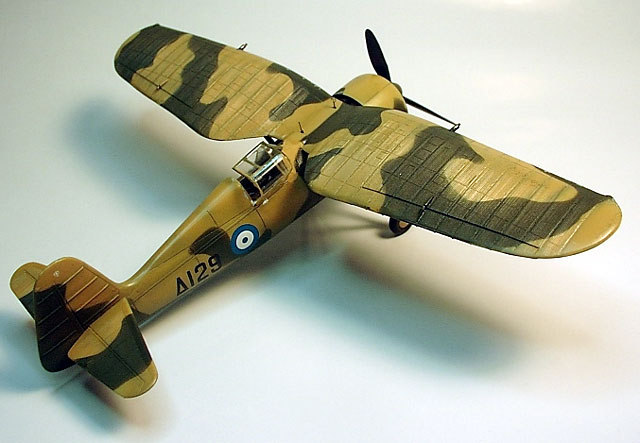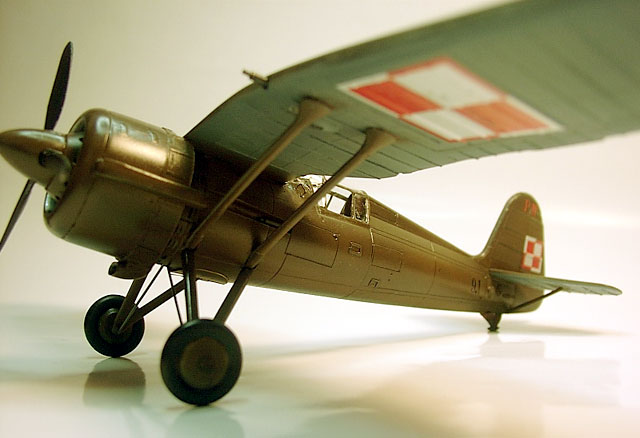|
Puławski’s Family of Fighters
in 1/48 Scale
by Artur Golebiewski
|

|
|
PZL P24f |

Mirage
Hobby's 1/48 scale PZL P11c is available online from Squadron
After several years of
waiting, a modeler is finally able to replicate accurately the most famous
of all the Polish fighters, the PZL P11c.
I wanted to take advantage
of this opportunity in order to make all the PZL fighters, the majority of
them based on the new release from Mirage but also the Warrior Model resin
model.
PZL P7a “siódemka”
The PZL family in the Polish
Air Force was started by the PZL P7a…the “siódemka”. This was a model,
which being vastly different in design, and cannot be “backdated” from the
PZL 11. Instead, I used an old, Broplan vacuform for this project.

The model is of poor quality
and especially irritating is the “hand made” rivet patterns along the
sides…fortunately the camouflage is dark enough to hide a lot of the
disappointment. This particular model is made in the markings of the
Polish Air Force Fighter School at Deblin. By September 1939 it was
hopelessly outclassed in speed and armament. Most of them were relegated
to training but there were two front line units still armed with the
fighter. They left a good account of themselves but their few victories
were very costly in losses, and were withdrawn or destroyed within the
first few days of the war, some were later relegated to reconnaissance
roles for the various Polish Army Units. This particular machine was flown
on September 1st by Witold Urbanowicz, one of the instructors at the
school.
Click the thumbnails below to view larger
images:
PZL P11a
The family is followed by
the P11a. The fuselage again came from the Broplan vacuform with its
inherent surface problems, but “everything else” came from the excellent
Mirage kit and the PART photo-etch sets. The radiator was made from the
PART kit, which however has some shortcomings. The intended and instructed
way of assembling the radiator only gives us room for about 17 ribs and
not the original 24, The instrument panel is not exactly aligned with the
film with the instrument and those need to be cut out and refitted. The
decals come from the old Broplan kit for the “Kosciuszko badge” and
everything else is form Mirage.

The markings for this
particular kit are again those for a machine flown by Witold Urbanowicz,
but earlier, in 1936 when he served with the 111 Eskadra in Warsaw. In
August 1936 the Eskadra was moved East to protect construction of border
fortifications. For that reason they have been marked with the letters
K.O.P, standing for Border Defense Corps. The Soviets flew reconnaissance
missions frequently overflying Polish territory and usually were chased
off by Polish fighters. This one particular August morning the crew of the
R5 opened fire on Urbanowicz’s P11a. This was their last mistake and
having been attacked Witold was free to open fire. The incident was hushed
up by both countries and Witold was removed from active service in the
Eskadra and moved to the Fighter School soon after.
Click the thumbnails below to view larger
images:
PZL P11c
Next is the “standard” P11c,
which is probably most familiar to Western modelers. The conversion I have
done to it is to try and replicate a “field” repair performed by Polish
mechanics on the Night of September 1st. During the day Heronim Dudwal
flew the machine and gained a victory over a German Bomber but suffered
machine gun and cannon hits in the fuselage top rear section. This was
“patched” by the mechanics overnight and successfully flown to at least
one other victory.

I achieved this effect by
gluing the two halves of the fuselage together and then filing down the
rear section. The resulting hole was filled in with Miliput and then
smoothed over with 2000 grit sandpaper.
Over that I decided to glue
a section of very thin metal plate. I chose metal because it was easiest
to replicate the riveting by simply indenting it with a “not too sharp”
needle. This was later glued into place. This was never painted over by
the mechanics and simply left in the aluminum color of the metal.
The other markings shown are
the “almost painted over” top checkerboards, which was done also on the
first day of the war in order to hide the machines better on well
concealed temporary landing fields out of which the fighters operated.
Click the thumbnails below to view larger
images:
PZL P11g “Kobuz”
Next we have a model of the
one and only model of the P11g “Kobuz”.
The Polish authorities only
in 1939 realized how far the Polish Air Force was behind the Western
Powers. With the impending conflict with Hitler they desperately tried to
plug the technology gap by getting some French MS 406’s and some British
Hurricanes. On the home front it was becoming apparent that the PZL P50, a
modern, low wing monoplane (somewhat similar in looks to the Seversky P35)
was coming far short of expectations in speed and it was decided to use
the Mercury VIII engines, already produced and “match” it to the existing
PZL P11c airframes.

In late 1939 the first
conversion was performed at the Okecie Aviation Works. The plane was given
the covered cockpit of the PZL P24. It was completed and successfully
tested just days before the outbreak of the war. On September 5th it was
evacuated by flight from the Aviation Technical Institute in Warsaw to
Lwow. There it was repainted in camouflage to cover its stark, NMF finish
and flown to Grodek Jagiellonski.
On September 13, it was
flown to Wielick where it was armed by the mechanics with four machine
guns. On September 14th and 15th it was flown by Henryk Szczesny, one of
the Fighter School Instructors, and he successfully downed a Heinkel on
each of these two occasions. On the 15th the machine was damaged by the
enemy and Henryk was injured in the leg.
Nothing further is known
about the machine. It was probably left behind and destroyed by the
Russians or the Germans.
Click the thumbnails below to view larger
images:
PZL P24 F & G
Lastly we see the PZL P24,
the export versions of the Pulawski fighter, one in the “F” configuration
with two cannon and two machine guns and one in the “G” standard with four
machine guns. The fundamental difference between the 11 and the 24 was the
engine, the 24 having the Gnome Rhone was about 40kmh faster. The other
difference was a covered canopy and in the case of the “F” version also
cannon armament.

The Greeks ordered 36 PZL’s
which were delivered in 1936, originally 30 were cannon armed and only 6
had four machine guns. This however has been quickly changed by the Greeks
to a point where almost all the PZL’s were in the “F” configuration of
four machine guns. The reasons for that were difficulty of obtaining
cannon ammunition, lighter weight of the “F” and more maneuverability. I
decided to make two P24’s from the excellent kit offered by the Warrior
Model company of Wroclaw, Poland, which in the US are available through
Pacific Coast Models. The kits are excellent as far as surface detail, the
“wibault effect” of the wings is even superior to the Mirage kit. The only
drawback I came across is the tendency of the wings to sag slightly and
the “misengineering” of the canopy, which makes it really difficult to
fit, without a lot of patching.

The camouflaged one, Delta
129 is one of the few examples of the “F” version surviving into 1940 so I
decided on making that one. Since the model comes only in the “G” version
I had to do a little converting. First I sanded off the ejection bubbles
for the inner machine guns. Then from some generic oversize bubbles from
one of the Luftwaffe kits I reshaped them with a lot of sanding, patching
and patience into those large cannon under wing pods necessary for the “F”
version. A hole was drilled on the front and the barrel of the 20 mm
cannon glued into place. The few vents were later added with careful
drilling and scribing. The struts had to be also reconfigured, not just
the length of them but also the “feet”, or supports attached to the cannon
pods. They are molded from flexible, white metal so filing and sanding was
not any harder then when dealing with plastic. I hear that Tadeusz of
Warrior intends on offering a conversion kit for his P24’s to achieve just
this, a conversion from guns to cannon, but I could not wait for mine and
did all the above.
The other kit is a standard
P24 as it was delivered by PZL to the Greeks and later converted to the
four machine guns. The machines were kept silver by the Greeks until the
Italians attacked in November 1940, at which time they were camouflaged
like my cannon armed machine.
And so ends the modeling
saga of the Pulawski family of fighters.
Click the thumbnails below to view larger
images:
Model, Images and Text Copyright ©
2003 by Artur Golebiewski
Page Created 26 February, 2003
Last Updated
17 March, 2004
Back to
HyperScale Main Page |
Home |
What's New |
Features |
Gallery |
Reviews |
Reference |
Forum |
Search